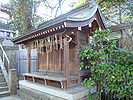The architecture of the 80,000 Shinto shrines in Japan varies depending on geographical location, the deity worshipped, and the date of foundation. The earlier Shinto shrines tend to be simpler and less decorative affairs than those which came after the introduction of Buddhism and Chinese architectural styles in Japan from the 8th century CE onwards.
Friday, February 10, 2023
Torii gate
A torii (torii gate) is a traditional Japanese gate most commonly found at the entrance of or within a Shinto shrine, where it symbolically marks the transition from the mundane to the sacred. The presence of a torii at the entrance is usually the simplest way to identify Shinto shrines, and a small torii icon represents them on Japanese road maps.
Itsukushima Shrine
Itsukushima Shrine is a Shinto shrine on the island of the same name, also known as Miyajima, located in Hatsukaichi, Hiroshima Prefecture, Japan. Traditionally founded in the 6th century CE, the present layout of buildings dates to the 12th century CE.
Kasugataisha Shrine
Kasuga Taisha is an ancient Shinto shrine located in a forest east of Nara, capital of Japan between 710 and 784 CE. Founded in 768 CE, the site has four main shrines in honour of four Shinto-Buddhist deities, one of which is the ancestor god of the important Fujiwara clan. The complex, including its surrounding forest with wild deer, is listed as a UNESCO World Heritage Site.
Ise Grand Shrine
The Ise Grand Shrine or Ise Jingu, located in the heart of a sacred forest in the Mie Prefecture of Japan, is the most important Shinto shrine in the country and is dedicated to the sun goddess Amaterasu with a separate shrine dedicated to Toyouke, the food goddess.
Fushimi Inari Shrine
Fushimi Inari-taisha is the head shrine of the kami Inari, located in Fushimi-ku, Kyoto, Kyoto Prefecture, Japan. The shrine sits at the base of a mountain also named Inari which is 233 metres above sea level, and includes trails up the mountain to many smaller shrines which span 4 kilometres and take approximately 2 hours to walk up.
Izumo Grand Shrine
Izumo-taisha ("Izumo Grand Shrine"), officially Izumo Ōyashiro, is one of the most ancient and important Shinto shrines in Japan. No record gives the date of establishment. Located in Izumo, Shimane Prefecture, it is home to two major festivals. It is dedicated to the god Ōkuninushi (Ōkuninushi no Ōkami), famous as the Shinto deity of marriage and to Kotoamatsukami, distinguishing heavenly kami. The shrine is believed by many to be the oldest Shinto shrine in Japan, even predating the Ise Grand Shrine.











